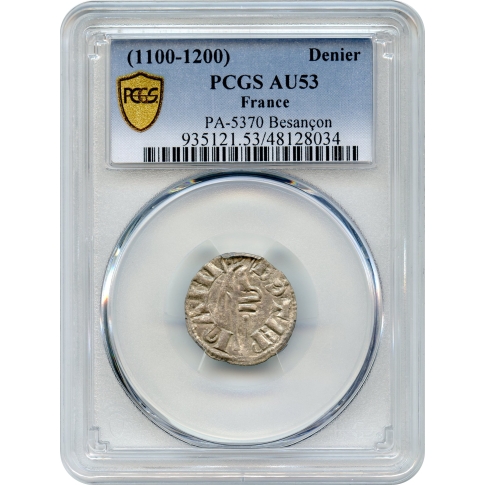World Silver France - 1100-1200 Denier, Besançon PCGS AU53
Archbishopric of Besançon. Anonymous, 12th century. Denier. PORTA NIGRA. The Black Gate. Rev. B.STEPHANI. The obverse presents a priest’s right hand raised in benediction, while the reverse is the Black gate, Nigra Porta. The Nigra Porta is a large Roman city gate in Trier, Germany. It is a UNESCO World Heritage Site. Very rare issue. PCGS has graded one as AU53 with none finer. PA-5370 Besançon.
The only mention we could find of Rev. B. Stephani in historical literature is in the PhD dissertation of Deborah Gail Shulevitz, Heresy, Money, and Society in Southern France, 1175-1325, in which she discusses heretics being given alms: “Occasionally, the money given was earmarked for something in particular that the recipient needed, as when Bernardus Stephani gave a heretic three solidi for the purchase of boots.”

The Porta Nigra (Black Gate) viewed from the north. It is depicted on the reverse of this offering from AUCM. Photo: Wikimedia Commons.
The Archdiocese of Besançon is a Latin Church ecclesiastical territory or archdiocese of the Catholic Church in France. From 1034 to 1184, the archbishop enjoyed civil authority within the Holy Roman Empire as the prince-archbishop of Besançon. He eventually lost his civil power to the town council. The city became the Imperial city of Besançon in 1184.
Local tradition tells us that the diocese was evangelized by Saints Ferreolus and Ferrutio, who were sent there by St. Irenaeus, the Bishop of Lyon. According to the Catholic encyclopedia, “Louis Duchesne proved that these legends belong to a chain of narratives forged in the first half of the 6th century and of which the ‘passion’ of St. Benignus of Dijon was the initial link.”
It was during the Medieval period that several popes visited Besançon, including Pope Leo IX, who consecrated the alter of the old Cathedral of St. Etienne in 1050, and Eugenius III, who in 1148 consecrated the Church of St. Jean, the New Cathedral. In 1162, a council was held at Besançon, presided over by Holy Roman Emperor Frederick Barbarossa, in the interest of the Antipope Victor IV against Pope Alexander III.
| PCGS # | 935121 |
|---|---|
| Grading Service | PCGS |
| Year of Issue | NONE |
| Grade | AU53 |
| Denom Type | World |
| Numeric Denomination | Denier |
| Mint Location | NONE |
| Designation | NONE |
| Circ/UnCirc | Circulated |
| Strike Type | Business |
| Holder Variety | Boudeau-1272; Poey d'Avant-5370. |
| Grade Add On | NONE |
| Holder Type | N/A |



